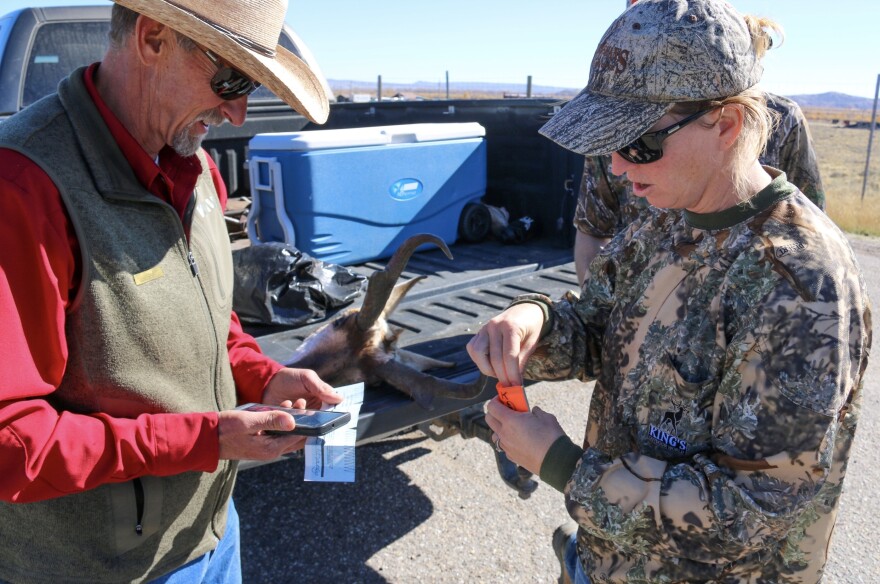On a sunny Sunday afternoon in the middle of October just outside Daniel, in Sublette County, the Wyoming Game and Fish Department (WGFD) are set up at a hunter check station near the highway. Hunters are required to stop.
Daygen Dickinson of Rock Springs pulled up and has a bull elk in his truck bed. Dean Clause, a longtime wildlife biologist for WGFD, greeted him.
“How are you guys doing? You got something for us to check?” Clause asked.
Clause is checking hunting licenses, tags, animals killed and also just chatting with hunters, like Dickinson.
“And how did it go? Did you guys see much?” Clause asked.
“No, those were the only elk we seen,” Dickinson replied.
That seems to be the trend this year. Hunters are having a harder time tracking down elk, largely because of warmer weather.
“We have had such a mild fall with warm temperatures that most of the elk are still at some of their higher elevations, more of where they'd spend, like, the mid to later part of the summer,” Clause said. “And so that makes it really tough.”
Really tough because hunters have to trek higher up and further into the mountains to find the elk, as the animals tend to stay in a cooler climate.
On this particular day at the check station, no one is wearing jackets – Clause even has his straw, summer cowboy hat on, but a few years ago, it might have looked a lot different.
“We've had days where we just pretty much can't wait to jump back in the cab of the truck just to warm up,” Clause said. “Winds blowing and it's snowing or has been, and the temperatures [are] a lot colder than now.”
Clause said the past three falls have been warmer and hunters have not been able to harvest as many elk. In fact, about 1,500 fewer elk are being harvested from a three year average compared to 10 years ago.

And this is actually creating a bigger problem. If hunters cannot fill their tags, the elk population keeps growing.
One might ask, “So what?”
Well, Lincoln Larson, an associate professor at North Carolina State University, used to think that too.
“I'm a wildlife ecologist by training, my parents are pretty much hippies. And I've never been hunting myself, and I don't have any guns,” Larson said. “So I'll go ahead and confess that, however, I still care deeply about hunting.”
Larson studies natural resource management and said hunting keeps big game populations in check, as too many of one animal can upset the balance of the ecosystem.
“Hunting is necessary for over abundant populations of species like deer, who, you know, used to have natural predators," he said. “And now, we're pretty much it after we exterminated all their natural predators.”
Elk populations in Wyoming for 2021 were about 117,000. The objective population the WGFD has set is more in the 80,000 range.
Larson added that another way to address overpopulation besides hunting is reintroducing natural predators – like wolves.
“And you know how controversial that can be. And so yes, that's a solution. It's not always a socially acceptable one, or even an economically feasible one,” Larson said.
Wyoming began reintroducing wolves into Yellowstone National Park in the mid-90s. It continues to be extremely controversial between ranchers and environmentalists. Some studies show that wolves have helped regulate elk populations in the park. But there is also a fear among some that too many wolves outside the park could hurt cattle populations.
But for now, hunting is the most acceptable population management tool for elk in Wyoming.
Clause, with WGFD, said if it does not get snowier and colder in November, “I can guarantee we're going to have more elk on the ground than what we did the same time last year so we'll probably be trying to devise maybe seasons that add a little bit more opportunity and maybe some more licenses for the year to follow.”
Just last year, the Game and Fish added 2,000 more elk tags to help with overpopulation.
The Almanac forecasts a rainy and snowy November in Western Wyoming with temperatures averaging around 43 degrees – two degrees above the typical average.








